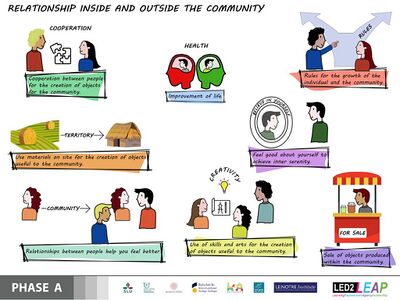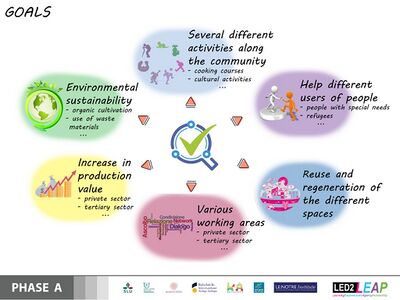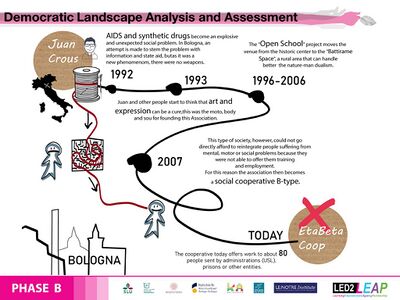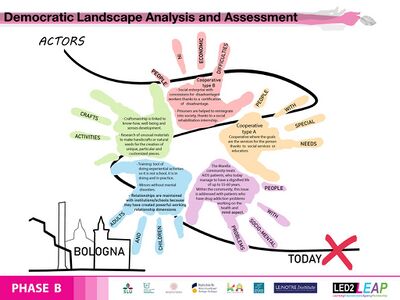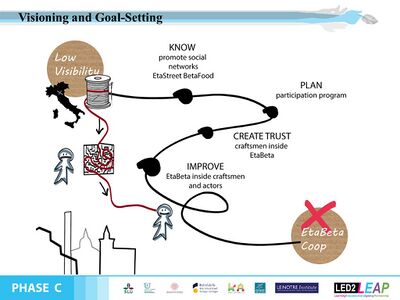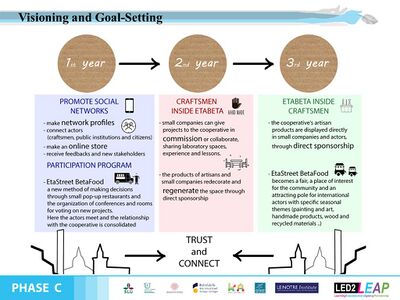LED2LEAP 2020 - Bologna Team 3: Difference between revisions
| Line 257: | Line 257: | ||
<gallery caption=" " widths="400px" heights="300px" perrow="3"> | <gallery caption=" " widths="400px" heights="300px" perrow="3"> | ||
File:B3 D11.JPG|''Literature'' | |||
</gallery> | </gallery> | ||
Revision as of 09:17, 5 July 2020
>>>back to working groups overview
Landscape Democracy Rationale
- This community is a challenge for the metropolitan city of Bologna, which has been buried behind little publicity or information.
Starting from the common principle that it is based on pillars:
- man
- health
- creativity
The cooperative has developed trying to connect abandoned spaces, in disuse and degradation of the urban periphery.
Location and scope
Phase A: Mapping your Community
Welcome to your community and its landscape
- Eta Beta is a non-profit cooperative formed by President Juan Crous and 14 other members
to bring together all those people who have little voice in society in a community in the outskirts of Bologna.
Groups of actors and stakeholders in your community
- The main actors of the community are groups of students, volunteers and families who cooperate in various initiatives.
These include several sensitive categories, which however do not interact with each other and exclude new points of view.
Relationships between your actors and groups
- The community involves several groups for different activities:
- cooperation to create objects that are sold inside the company's workshops
- reuse of abandoned spaces through community work
- sale and involvement of the neighborhood through events
- contribute to feeling good, both physically and within society
Summary of your learnings from the transnational discussion panel on April 22
Since the presentation of phase A we have discovered new methods of thinking and development of international analyzes and ideas.
- From the Dublin team we noticed that their method of analysis is very much geared towards the sustainability of the intervention.
- From the Freising groups, on the other hand, we investigated new methods of graphing and analyzing the territory.
We were surprised by the diversification of representation.
Theory reflection
- Reflect on at least three readings from the first section 'Democratic Landscape Transformation
- You can choose references from our reading list or suggest others
- Scope: 250 words
References
- https://www.etabeta.coop/ Official website
- Direct or indirect communication with the association
- Company balance sheet
Phase B: Democratic Landscape Analysis and Assessment
The Scene in your Story of Analysis
- Our story begins with Arianna in the mitology, who tends her yarn to get Theseus out of the maze once he has killed the minotaur. With this reflection, we bring with us a guiding YARN into the history of the EtaBeta cooperative, which for twenty-seven years has been aiming at all those people who cannot get out of the maze.
- Summing up, the stages of the cooperative moved from putting ideas in the center, to putting people themselves at the center.
The cooperative was born as an association of artists who participated independently and with private titles in the rehabilitation of people with social, mental and physical problems through various forms of art as music, painting, etc.
In 1993 synthetic drugs became a big problem in the city of Bologna and so the following physical and social problems related to their use, those situations marked the advance of a problem never faced before: AIDS and overdose, problems that didn’t see a real resolution until after the appearance of the first treatments in 2006.
In 1996, therefore, the OPEN SCHOOL project started, always centered on the development of personal art, the association moved from the city center toa rural area looking that people could reconcile with theirselves and increase their sensitivity to living in a healthy system.
This type of association, however, did not allow to be able to reintegrate people through work, so they moved to a type B non-profit cooperative (at the legislative level) to be able to hire these people in difficulty and give them a concrete development in their new life as a symbol of social rebirth.
The Actors in your Story of Analysis
- In etabeta there are several actors, on first place they have people in economic difficulty where consigned social enterprise help these disadvantaged workers thanks to a certification of disadvantage, this certification must show to be greater than 40% to participate in the association. The objective in general is to increase the productive labor force.
Furthermore, ex-prisoners are also helped to reintegrate into society through training placements.
Other actors are people with special needs because they are helped by educators and social services.
People with socio-mental problems are also trained to be able to work on the duality of health and mind that underlies the beta age.
Also the relationships between institutions and schools are maintained to create powerful working links, in fact people are lay off from work only when they create big problems within society because they try to keep the working relationship as stable as possible.
Finally, the craftsmanship is linked to durability, well-being and the development of the senses, and thanks to the search for unusual materials they create pieces of particular value.
The Story of Analysis
- In 2006-2007 the etabeta social cooperative was officially born, and they immediately began to deal with the theme of handcraft that has the value of a kind therapy.
They are looking for noble, raw or natural materials such as glass, wood and other, for the creation of objects (lamps, glass plates, toys, box ecc ..)that are generally brought to the bottom WITHOUT AN ASSEMBLY CHAIN. Its a kind of war against the industrial productin where the human side is totally missing.
Later they participated in the cop25, the ONU Conference on Climate Change, with glass plates created by them
Reflect on your Story of Analysis
- In the reflections we asked ourselves where the YARN will be led, and how others will intersect Etabeta’s YARN.
From phase A, therefore, we have deepened the unheard voices and, through an interview with the president of the cooperative, given them a way to be the subject of reflection
First we find the necessity of connection to other realities outside Bologna, this for greater cooperation beyond borders, but the most important yank will be stretched in favor of young people who, until now, have been little listened to and need to be integrated into the community.
During the Covid-19 emergency, in fact, young people are the key to help even during the pandemic, becoming an irreplaceable part of the cooperative, an unheeded call that will find space within the non-profit organization during the near future.
In conclusion, Etabeta can make sure to unroll new YARN for a greater connection, and to be able to help other realities get out of the maze.
'
Phase C: Collaborative Visioning and Goal Setting
The Scene in your Story of Visioning
- Since the last meeting we have found a problem of popularity of the association, it is not well known, not even in its own city.
Our goal is to reconnect the fragmented places of etabeta with the city and people and we want to do it through four fundamental points: make connection, reorganization, events and sponsor. To make etabeta a visible connected part of the city.
The Actors in your Story of Visioning
The Story of Visioning
One of the objectives is to create a participation process between different actors such as companies, organizations and citizens. For company it has been decided to create a direct sponsorship trough showrooms of handmade products, meaning objects, furniture and design products by eta beta for a common goal. Both public and private organizations can create cooperation to promote social and cultural activities to encourage solidarity. Citizens instead can try to create a community in the city of Bologna to promote a relationship and union between the different sectors for a common interest.
Our vision speaks of how to make the cooperative more visible, connect it to different actors and make it become part of an amplified network that can listen to many more voices of society.Once the goal has been set, we therefore need to stretch our yarn to untangle the next steps and understand which is the best way to implement them. So we defined some main nodes: - know: through social networks and temporary events the cooperative can raise its head and involve a greater number of actors also in future decisions - to plan: through participatory actions, discuss what are the opportunities that are created by connecting to social networks and vote for new goals - create trust: through the entry of small artisan companies into the cooperative, a feeling of trust begins to be created - improve: by making sponsorship and trust a two-way street, Etabeta can make room in artisan companies and as a promoter become visible to new realities
so let's imagine the first 3 years of our vision as a way to partially get out of low visibility by joining a wider group of actors (the majority of which will be private) consolidating those who already make improvements within the cooperative (institutional bodies). In the first year, promotion actions are activated through websites and social networks, such as the creation of a specific app that can lead to the use of all the etabeta services within a single click. Furthermore, in order to decide the further steps, we imagine an alternative participatory process that would take place as an event inside Spazio Battirame, named EtaStreet BetaFood. Here, actors and active participants in the cooperative would meet in front of an indoor neighborhood dinner that could make citizens interact and vote in the following phases of the institution. this is also a good way to find new funds for initiatives. During the second year, artisan companies or organizations can therefore book, share and amplify their space within the cooperative, leading to exhibit their products, which through the application of labels, furnish and regenerate the space. Greater interaction occurs through commissions entrusted directly to the cooperative, such as the creation of plates, furniture, building materials, vases. In the third year we imagine the reverse process or through this new relationship of trust, EtaBeta can display its products inside companies and small artisans using labels and brochures obtaining its own space within new realities. In the same way, the participatory process that continues to assist the cooperative's decisions could widen becoming a fair, or a series of seasonal and thematic events that can unite the new actors and make them interact with each other. EtaStreet BetaFood thus becomes the way to find new funds and sponsors for the realization of new ideas and actions.
Reflect on your Story of Visioning
Arriving at the reflections, we imagined a process that could translate into a series of incoming and outgoing objects to obtain a summary of the method we have undertaken. As a first step we understood and analyzed the problem and the actors, tried to group them and connect them to the cooperative and finally thought about what better process they could have. The vision has therefore led us to take the path of interconnection, active participation and consolidate what already works well within the cooperative (towards know-how). we expect this vision to lead us to new processes and ideas which can therefore go beyond the objective of making the cooperative more visible, and which can therefore think of continuous growth.'
Phase D: Collaborative Design, Transformation and Planning
Your Prototyping Action
The Evolution of Your Prototyping Action
The Plan Behind Your Prototyping Action
The Realization of Your Prototyping Action
- What happened, who was there and what was the atmosphere like among the participants?
- add the corresponding visual from your presentation to the image gallery below
Reflect on Your Prototyping Action
Phase E: Collaborative Design, Transformation and Planning
* template coming
= Phase E: Collaborative Evaluation and Future Agendas * template coming
Process Reflection
- Reflect in your intercultural and interdisciplinary team on the outcomes of your study
- Which limitations were you facing?
- What have you learnt from each other?
- What would you do differently next time?
- You can also use diagrams/visuals
- 250 words text





